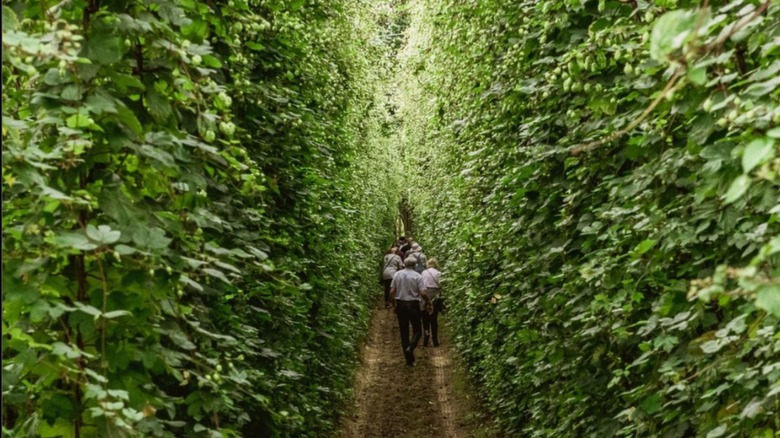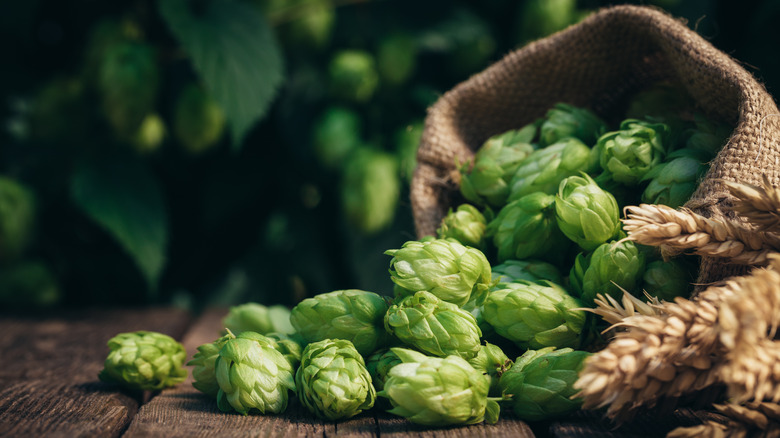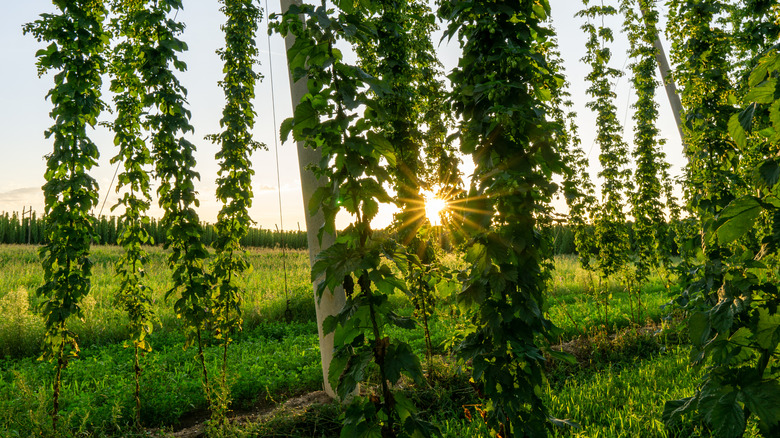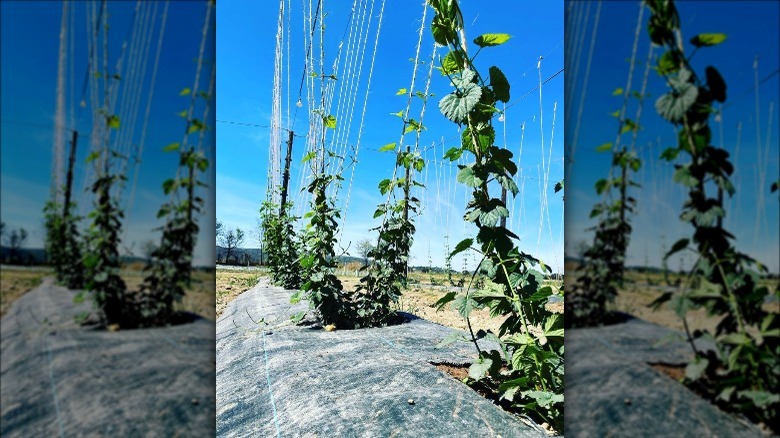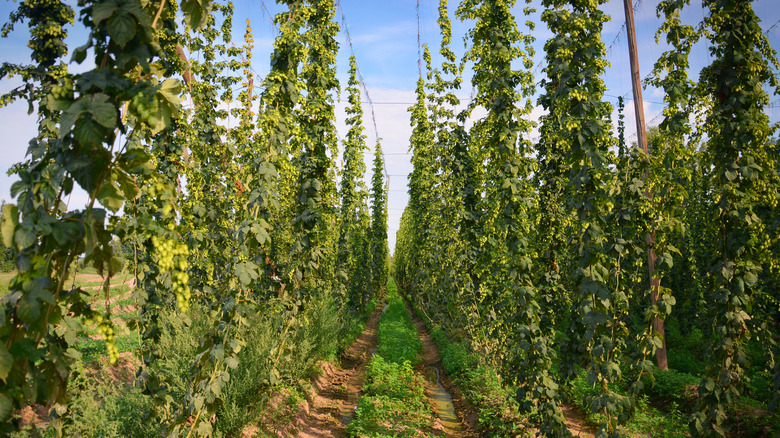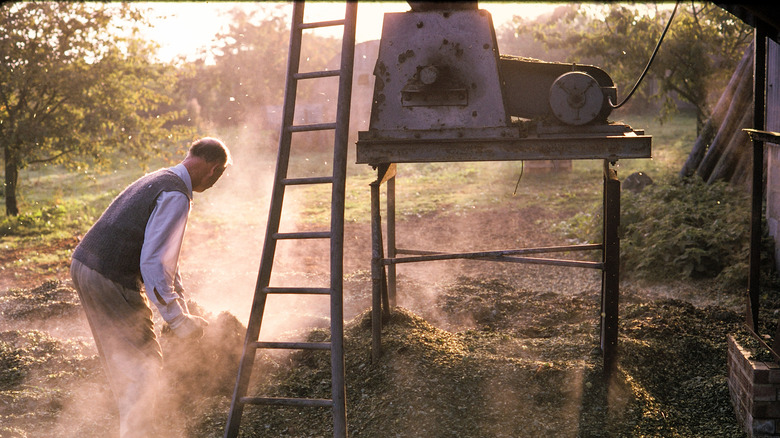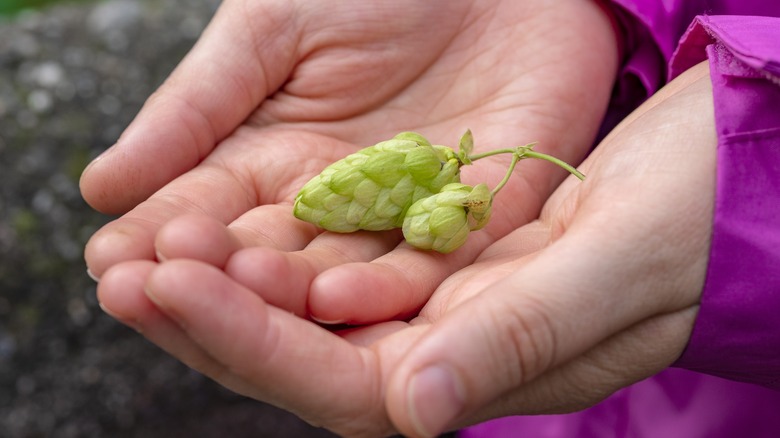How To Grow A Hop Vine Fence
Hops are climbing plants that are seeing new popularity in both landscape and urban gardening designs. More than simply a resource for brewers, hops are taking on a new appreciation in the plant world as both a resource and as a landscape feature. Climbing as high as 14 feet, these fast-growing vines are generally simple to cultivate, providing a thick, green wall of foliage.
The Vancouver Sun cites the "surprising popularity" of cultivating these plants at home, noting the statistic that over one million young men between the ages of 18 and 24 grow hops. John Briner, longtime brewer and grower, suggests one reason for this increase in a non-traditional gardening group of people is the boom in home and craft brewing that started in the late '90s. But while this growth of home brewing and hop cultivation may have begun with men, it's been embraced by a wider population, including the female brewer's group, the Pink Boots Society.
And while brewing may be the main appeal, the value of these attractive plants as ornamentals and landscape features should not be underestimated. Dave's Garden notes this plant is "vigorous" and easy to train to a trellis and that, unlike mint, it's "not invasive" so won't spread.
What are hops?
Sierra Nevada describes hops as being the source of "bitterness, aroma, and flavor in beer." Grown as a perennial vine, these plants have flowers, or cones, that are harvested and prized by brewers. These cones are sometimes also described as the "inflorescence" of the Humulus lupulus plant. Lupulus refers to the small yellow pods (think a bit like a larger oily pollen) called lupulin that are the source of that hoppy goodness prized by beer lovers.
The national brewers at Sierra Nevada describe how brewers source hops from locations that include Germany, Czech Republic, New Zealand, and North America, but that North American hops are generally sourced from the Pacific Northwestern states. While beer hops may be the best-known varieties both home and commercially, hops are cultivated in different varieties for different purposes too.
Oregon State University Extension notes that hops are also used as landscape plants, cultivated for medicinal use, and also used as a source of livestock feed. All types of hops are based on a vine which is actually called a "bine" and twists upward as it climbs clockwise. The specific climate needs of hops restrict most of this plant's growing area to climates between the 35th and 55th degrees latitude on the maps although varied success has been reported based on exact growing conditions.
How to plant in your fence garden
The basics of planting hops in your home garden or a commercial spot are the same. Hops are planted as rhizomes. A rhizome looks like a root, but it's technically an underground plant stem, according to Gardening Know How. Rhizomes are common with perennial plants that seek to store energy underground during the off-season. You won't find hops seeds at your local store but instead rhizomes to begin your planting.
Craft Beer and Brewing has some tips for home cultivation. Begin your planting after the danger of the last frost has passed, usually in March or April in North America. Plant your rhizomes 3 to 6 feet apart as dictated by the various guidelines and bury them 6 to 12 inches below the garden surface. Orient each rhizome horizontally and start a light watering routine. The idea when planting hops is to water enough to get the plant growing and emerging from the soil, but not adding so much water that the rooty rhizome will begin to rot. Beer Maverick recommends choosing a location with plentiful sun, slight elevation, good drainage, and southern facing exposure, if possible. in North America.
Once the hops plant emerges from the ground, growth starts progressing quickly — as much as a foot a day at certain stages.
How to shape your vines into a fence
Gardeners at Rutgers explain that while hops have both male and female plants, you do not need both for beer-brewing bliss — just the female, cone flower producing variety. The more difficult part of growing hop vines (or bines) comes in the preparation of your layout. While earlier spacing was mentioned noting that rhizomes should be at least 3 feet apart, vertical spacing must also be considered. Rutgers experts explain that you can use balconies or fencing to string up your plants to help them grow straight. Commercial growers often use poles with wires for this. Since this fast-growing foliage can reach as high as 20 feet tall in their Pacific Northwest home, home growers across the US and elsewhere might instead consider a 10-foot trellis to facilitate easier harvest.
Gardening Know How reiterates the need for both support and scale, noting the bines will start growing horizontally once vertical space is used up. When growing at home, connecting to existing tall structures may be the simplest and most affordable way to create your foliage fence. Try using baling twine to link your growing hops to a flag pole, house eave, clothesline, or an existing trellis. You may need to add reinforcements or additional trellising depending on the area you wish to cover with growing hops.
How to care for your hops
Caring for hops begins first with proper planting in soil that won't stay too soggy and then teaching your bines to grow into the right area. Rutgers advises training robust vines on baling twine connected to your larger height support starting at 2 to 3 feet in length. Wind the bines clockwise to get them started and secure with additional twine if needed. As these root systems get established, you can continue to care for the larger vines and trim back the grounded 2 to 3 feet of shoot and leaf, which can be stripped away. A larger task is to make sure the remaining vines continue to wind and not tangle.
Gulley Greenhouse & Garde Center recommends continuing to carefully tend to your soil health and watering until vines are fully established. Continual pruning throughout the summer will not only help prevent the dreaded tangles but can also help avoid the two most common hop ailments (aphids and powdery mildew) by ensuring good airflow.
How to harvest hops
Commercial hop harvesting can be done with specialized tools, from simple stilts to complex machinery. Home hop growers will need to get a little more creative on their smaller scales for both medicinal and brewing uses. The American Homebrewers Association recommends having patience in your hop harvest. Don't start at the first sign of flowers, but wait until mid-August or September instead. Cones are ready for harvest at the lighter and dryer part of the growing stage. Gardeners can tell when these are ripe by pressing the cone and noting it "pops" back to full or putting it up to their ear and listening for the "cricket" sound. Cones are past-ripe if they smell rancid or turn orangey.
Harvesting is best done by hand for home growers. Simply pick the cones one by one on first-year bines. For second-year growth and above, cut down the entire bine and strip the flowers, leaving 2 to 3 feet of growth for the winter. Make sure to use gloves in the harvest process. Brewers will then often dry these hops prior to brewing, although not all harvesters prefer a dried preparation.
For those growing hops for ornamental use, simply sit back and enjoy the cone flowers.
Cautions and considerations when growing hops
The American Homebrewers Association cautions that hops have what is described as "hooked hairs" when harvested, so it is suggested that gardeners use proper hand and eye safety equipment during the harvest. When using for beer, there are many distinctions between hop varieties and preparations. Novices may not get the expected results when trying different brewing mixes and methods, so it's best to research your hop varieties online, such as at More Beer's extensive hop listing.
Hops are most generally considered safe to consume medicinally, but WebMD offers some notes of caution. Ingesting hops can cause sleepiness or dizziness in some. This sleepiness should not be combined with anesthesia. As hops have some estrogen-like properties, they are also listed with caution for those with some cancers or persons who are pregnant or breastfeeding.
One final caution on growing hops, as discussed by Homebrew talk, is the invasive nature of this plant. While not considered an official culprit on the invasive species list, hops are still frequent and aggressive spreaders and may dominate your local landscape plants. While prolific growth may be the goal of your privacy fence, it should be managed with caution, depending on your scale.
